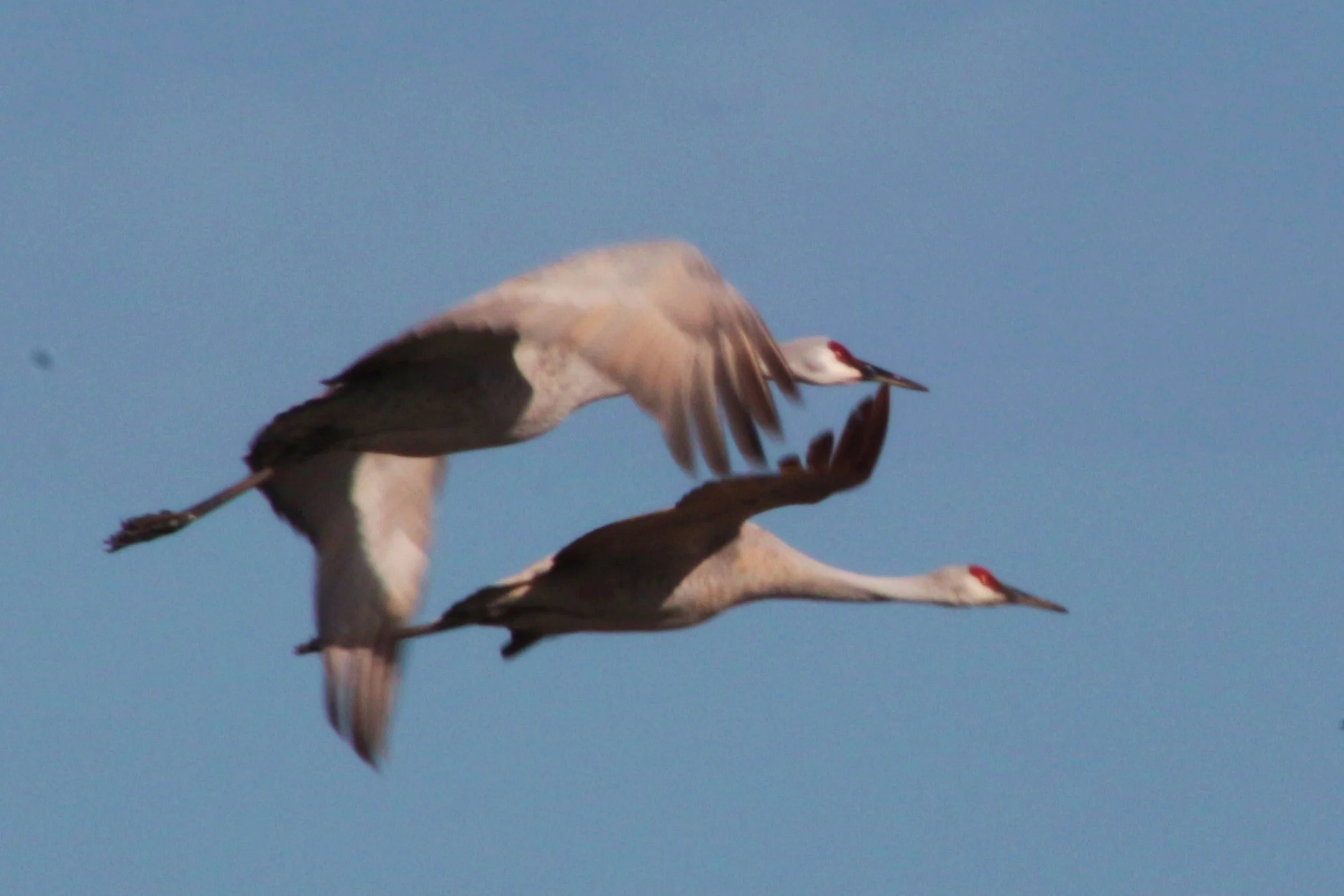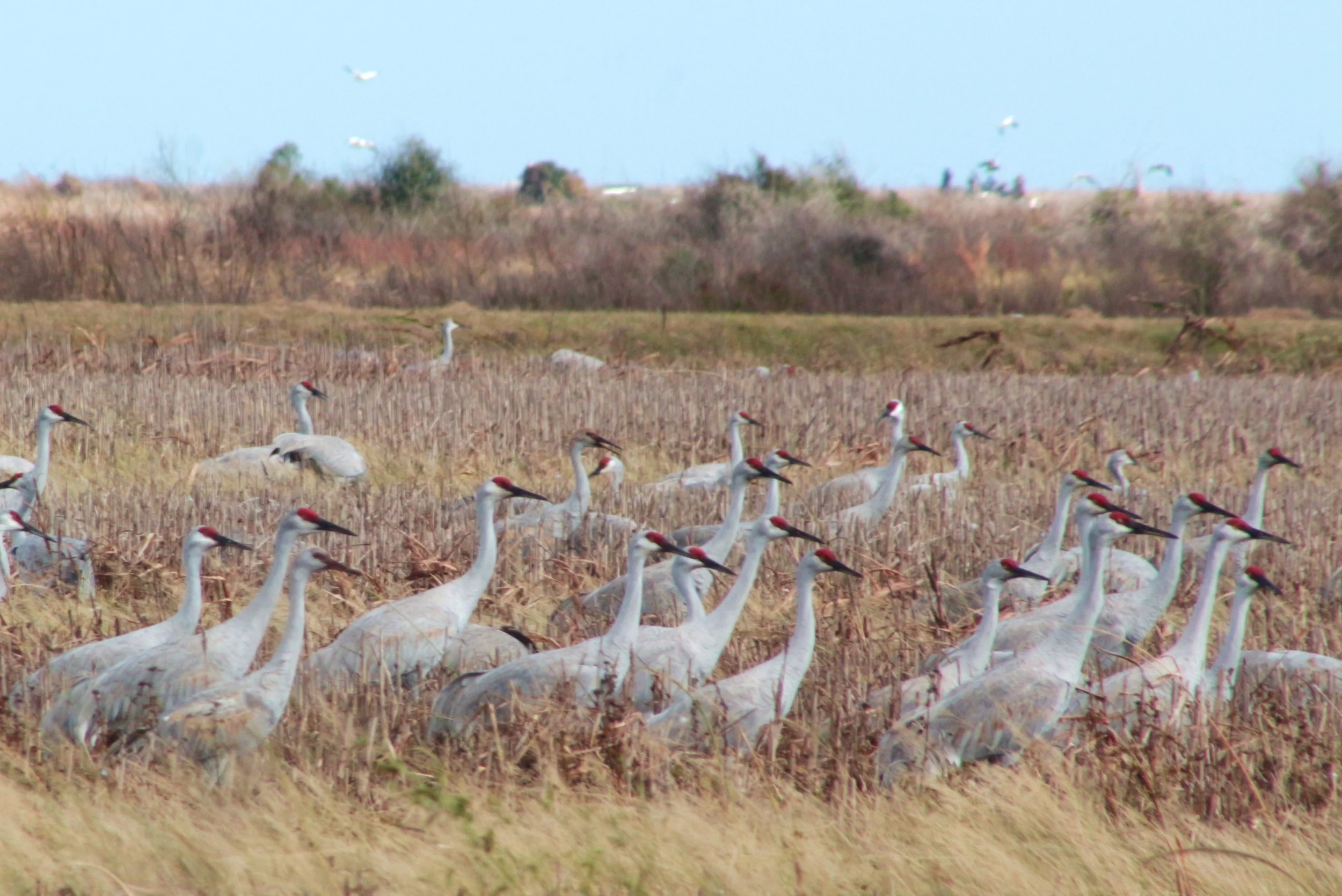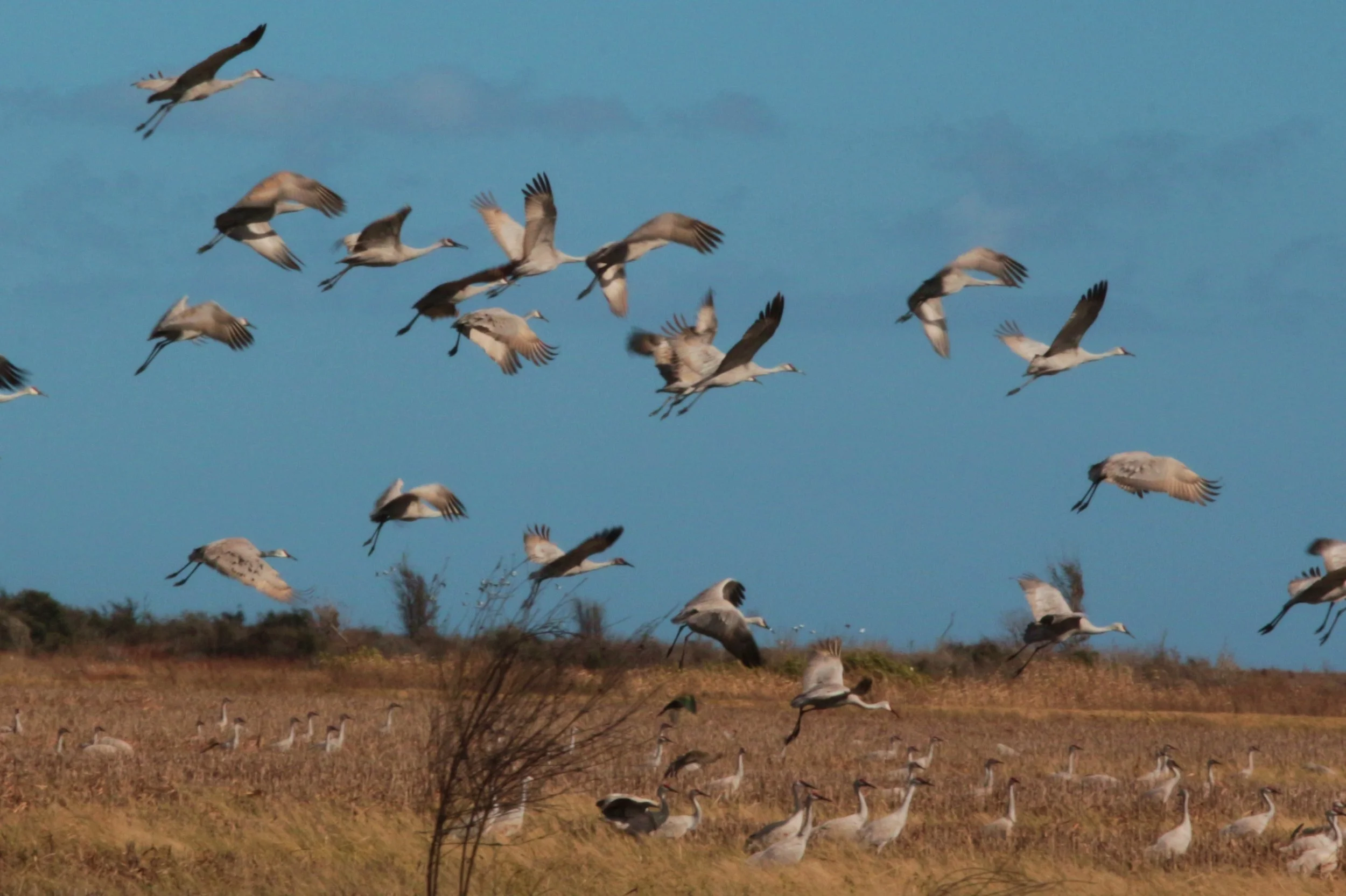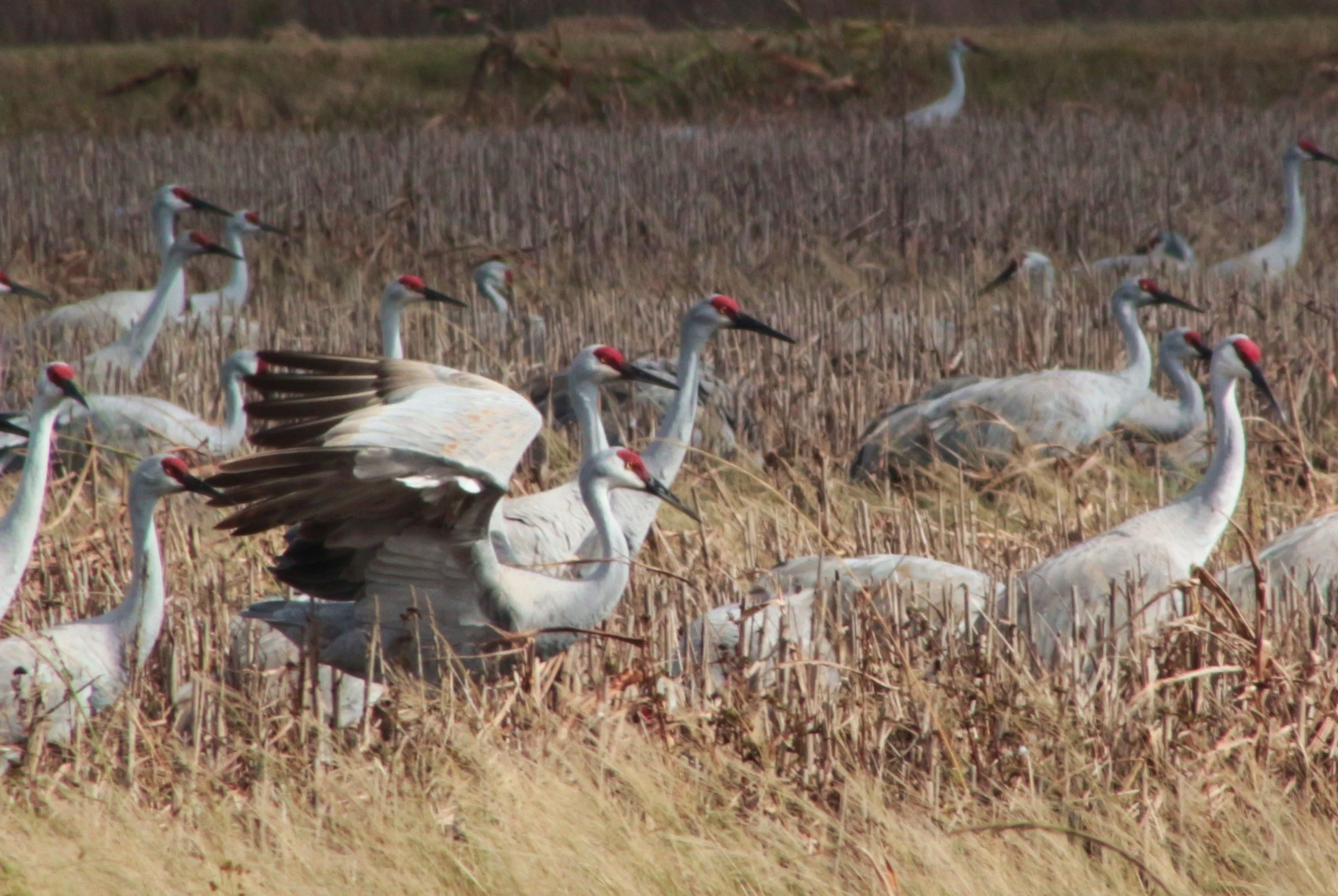Migratory Birds, Finding the Travelers
12/10/2022 By Sherry Thornburg
It was late spring, and I was getting restless with the way I was birding. I enjoyed my backyard and visited the local parks on weekends, but I wanted to get farther afield. I wanted to find new birds. There are times when you just get hungry for more. So, I spent time enjoying other people’s bird pictures on the internet and getting into my bird books. Books are great and I’ll talk about building a library later, but for now let’s talk about all those beautiful pictures I was seeing on the Birds of Texas Facebook page, and what a little birding envy can bring.
Internet Birding groups are a way to keep up with other birders and what they are finding. If you don’t do this, you are missing something wonderful. Birders flock too. While I hadn’t found any local birder flocks to join, this group was making up for it. They showed me amazing new birds.
In the fall, one bird being featured was the Sandhill Crane. The pictures were coming from the Platte River area of Nebraska, where the posters had been for a big festival, before the cranes head to Canada and Alaska. They said the cranes arrived after leaving Texas in January. I later stumbled on an article on a site called the Nature Writers of Texas that claimed the cranes show up in Texas in October. Hmm, where do they show up?
This lovely long-legged bird moves through the Central Flyway from Minnesota, Wisconsin, and Michigan, Oregon, Idaho, and Alaska, where they breed. My North American field guide gave me the basics about the bird. Some field guides also give possible locations. But this is old school, still relevant, but there are other ways to find this minute relevant info about birds.
New School Research
I continued combing the internet. Researching has never been easier than when the internet came into wide public use. Without it, knowing what birds were in your local area and where they could be seen would have required being part of a local birding group or having well connected friends. Finding out about rarities involved the birder telephone chain.
Now, such information is just a few keystrokes away. Starting with your state’s Bird Records Committee is a good idea. The Texas Records Committee and other state committee information is on-line. I also ran across whatbird.com. This link shows their lists for birds by state. Scanning their lists will show what birds you could find in a given area.
The most helpful tool is E-bird, the mother of all citizen science projects, providing the where and when reported by thousands of birders. All this was new to me back then. I found them by recommendations from friends in Birds of Texas. So much information, maps showing you exactly where other birders are finding their catches. I dug in, planning to follow their trail.
Birding Apps
Texas Bird’s Eye was my next discovery. It’s a wonderful birding app with lists of birds by area and maps telling where the birds are found and when they were seen. Today, Birds Eye is in partnership with E-Bird, a win for both organizations. I never imagined real-time information about hotspots and species with full directions.
I started using the app in September looking for where the cranes congregated. After looking up the bird itself, I called up the sighting map. It showed all the hotspots Sandhill cranes had been seen and checklists for each location, which are reports uploaded by other birders. First stop, one of my go-to places, Anahuac NWR. Great birding there any time of the year. I found no cranes.
Then I went to Bazos State Park. Same deal. Loved the trips, but I was getting nervous. Am I doing this right? Maybe I was, and maybe I was just seeing where they had been. By now, its late November and I’m worried I’ve missed them, but I set my hopes on Brazoria NWR.
The Chase is On
I told my husband about it. It was a long drive, and he wasn’t on board with me wondering the state by myself. I had gotten him to take me on this quest before, striking out twice. Greg loved me very much to go birding, as a non-birder. He, however, is a much better spotter with years of stalking experience as a hunter; but he hates traffic. We would have to go across Houston to get there.
Heading south in late-November, we finally made the third try. We drove through Houston and into the flat prairies of Brazoria County. The directions sent us through long country farm roads, getting turned around a few times. We were driving by birding app. Getting frustrated, Greg switched to google maps, his preference.
The Final Chase
I told my husband about it. It was a long drive, and he wasn’t on board with me wondering the state by myself. I had gotten him to take me on this quest before, striking out twice. Greg loved me very much to go birding back then, as a non-birder. He, however, is a much better spotter with years of stalking experience as a hunter; but he hates traffic. We would have to go across Houston to get there. Heading south in late-November, we finally made the third try.
We drove through Houston and into the flat prairies of Brazoria County. The directions sent us through long country farm roads and getting turned around a few times. We were driving by birding app. Getting frustrated, Greg switched to google maps, his preference.
As we came up on the entrance for the refuge, there was a spent field on the left… full of cranes. I mean there must have been 500 or more. The first thing that came to my mind was a jubilant “Jackpot!”
We were one of 3 or 4 cars parked off the side of the road, watching and photographing the birds on the other side of a deep ditch and fence. We must have spent half an hour there before going into the refuge. There weren’t many seen elsewhere, but that huge flock at the entrance was well worth the long drive, even for my non-birder.
Know Your App and Check Your Timing
Birds Eye shows when birds have been seen by clicking on the bird in the species listing to see information on their yearly sightings in any given area. The location map will tell you where birds have been seen recently. There might still be birds there and there might not. My mistake was assuming the birds hadn't moved between when I saw the report and when I could travel. The upper Texas coast is not their final destination. Their wintering grounds are farther south, like around Rockport, and other places south of the border.
Take Away
Knowing what there is to find in your area and where to find them is key to the birding treasure hunt. The tools mentioned make the chase easier but knowing the birds of your area and how to identify them starts with good guides and reading. Next, I’ll share another chase, birding at the bookstore.
Photography
Title Image: Sandhill Cranes in Flight
Picture 2: Driving down I 45 to Brazoria
Picture 3: Field at the entrance of Brazoria NWR
Picture 4: Flock in Flight
Picture 5: Close up of Sandhill Cranes





